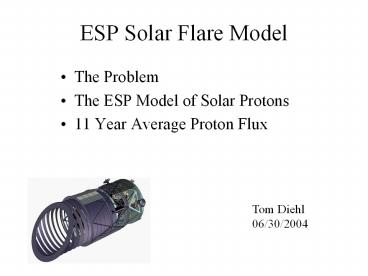ESP Solar Flare Model
1 / 9
Title:
ESP Solar Flare Model
Description:
ESP Solar Flare Model The Problem The ESP Model of Solar Protons 11 Year Average Proton Flux Tom Diehl 06/30/2004 Solar Cycle Projection NGST Radiation Environmrnt ... –
Number of Views:88
Avg rating:3.0/5.0
Title: ESP Solar Flare Model
1
ESP Solar Flare Model
- The Problem
- The ESP Model of Solar Protons
- 11 Year Average Proton Flux
Tom Diehl 06/30/2004
2
Solar Cycle Projection
- NGST Radiation Environmrnt Barth, Isaacs, Poivey
http//www.ngst.nasa.gov/public/unconfigured/doc_0
570/rev_04/ngstradenv2.pdf
- Solar flares and coronal mass ejections originate
with the sunspots - Plot on left is projected sunspot count.
- See large variation in solar activity.
Est. Sunspot Activity vs. Year (2009-2020)
3
The Problem
- Creme96 simulation provides
- Galactic cosmic ray fluences at solar minimum and
solar maximum - Worst 5 minutes, day, week of solar flares
- These are the extrema and the expected radiation
dose varies from 7 rads/yr to 200 rad/day. - We need a better model if we are to provide a
spec. for radiation dose.
4
Emission of Solar Protons Model
- I came across it in an NASA memo The Radiation
Environment GOES-R Series Satellites,
417-R-RPT-0027 (March 2004) and in NGST radiation
estimates, both by Janet Barth and Mike Xapsos. - They referenced their model. http//trs.nis.nasa.g
ov/archive/00000505/01/tp209763.pdf has the
write-up and http//see.msfc.nasa.gov/ire/model_es
p.html provides a link to software distribution.
5
ESP Model Results
- Input Ranges 1970-2020 and 50-99
- Results from 1970 to 1999 are based on actual
observations. - Results from 2000 on are averaged over previous
years in the solar cycle.
6
ESP Model Results
- Four part output Proton Flux vs. C.L. for
several C.L. and also the user C.L., same for
worst case solar event. - Energy range is 1 MeV to 300 MeV (k.e.)
2 // TYPE (1Input,2Output) 1998,1999,90
//INPUTS (Start Year,End Year,Confidence
Level) TOTAL PROTON FLUENCE FOR MISSION Results
for a mission of 1998 to 1999.(2 Active Years)
GENERAL CONFIDENCE LEVEL
TABLE --------------------------------------------
----------------------
Integral Proton Fluence(cm-2) Energy Levels
Confidence Levels() (gtMeV)
80 85 90 95
99 ------------- ---------
--------- --------- --------- ---------
1 2.44E011 2.89E011 3.56E011
4.85E011 8.68E011 3
8.62E010 1.02E011 1.27E011 1.74E011
3.17E011 5 5.09E010
6.16E010 7.82E010 1.11E011 2.16E011 .
. . . .
. . . . .
. . . . .
. . . 275
2.03E007 3.02E007 4.97E007 1.04E008
4.19E008 300 1.59E007
2.37E007 3.91E007 8.20E007 3.29E008
7
Proton Flux 2004-2015
- ESP Model provides solar proton flux estimates in
energy range 1 to 300 MeV at distance averaged at
1 A.U. - Provides any combination of years from 1988xx to
2020 and 50 or higher c.l. flux.
8
ESP Model - Plan
- Incorporporate this flux into MARS
- Get an update of the model from Mike Xapsos that
goes to higher energy - Overnighter to IEEE conference in Atlanta Ive
arranged to meet M.X.
9
Summary
- Obtained ESP Model used by experts to simulate
proton fluences from solar events in radiation
damage simulations for satellites at L2. - It solves the extrema problem and will allow us
to make reasonable estimates of the doses. - I plan to obtain an extension to the model from
the authors.































